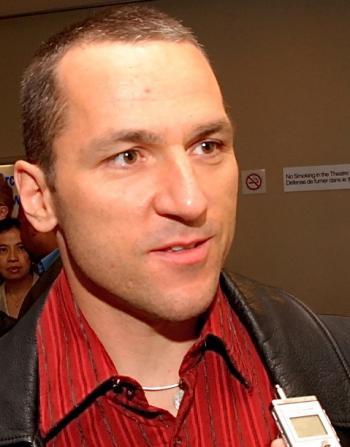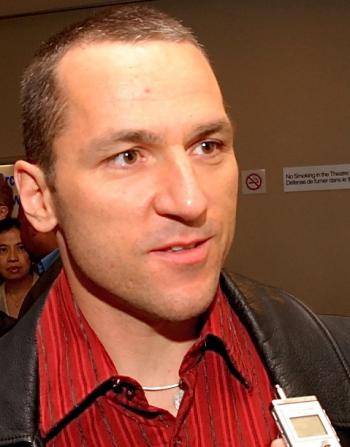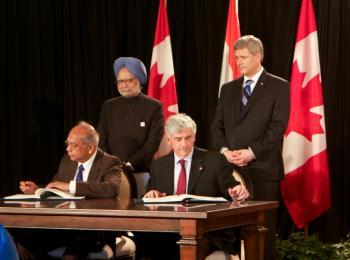TORONTO—Elvis Stojko is one of the most successful and well-known Canadian figure skaters to ever take to the ice. He’s a seven-time Canadian champion, three-time world champion, and two-time Olympic Silver medallist.
Saturday night, Mr. Stojko was at the John Bassett Theatre in downtown Toronto to watch Divine Performing Arts’ Mid-Autumn Spectacular. It was the first time Elvis had seen a Divine Performing Arts show.
“Everything was impressive,” he said afterwards, naming as prominent examples the two drumming pieces, the chopstick and fan dances, and content touching on Falun Gong. “Each single act had its own energy and character,” he said.
“In an interview afer the show, Stojko, who has practiced martial arts for 26 years, shared his thoughts on the Spectacular and his love for Chinese culture. The following is an excerpt of that Epoch Times interview with Elvis Stojko.
ET: Many of the performances in this show include classical Chinese dance. What is your impression of classical Chinese dance?
ES: I prefer it over ballet because it’s not just about the technique and just looking nice —it’s about showing the spirit and the energy of the dance. And that’s what is being conveyed. It’s not just about perfect technique and perfect toe point, even though they also have that, it’s about the energy and the essence and the spirit of the person doing it and what they’re trying to convey. The enjoyment of watching their faces as they’re performing is all part of it. Being a performer, I know you get that sense of freedom when you do that.
ET: As a figure skater you performed at the highest level. You’ve praised the skill of the dancers tonight. Can you comment on what it takes to get to that level?
ES: You see a lot of the dancers coming out and they’re learning all the dances. It’s not just one dance that they perfect — they’re doing all the different dances in the different styles. And there’s a different energy to each one, a different way of thinking to each one. There’s a perfection that goes along with it and a sense of pride.
As I was just saying, it’s not just about perfecting the movements, it’s about showing what they have inside as individuals in regards to the spirit and energy of what they’re trying to convey. You know, just like someone writing a story or speaking, the clarity in what you try to convey comes through the technique. Once you get through the technique, then people get touched by what’s there, what truly is there. Just like music, when someone sings if you hear the technique they’re not quite there yet. But if you don’t even hear the technique, you get a feeling, you get that sense of excitement, you get that tingle up your spine. Then you know that you’ve reached the people.
Because you go past the technique, you go beyond it. That takes years of training. It takes a sense of confidence in yourself and your ability, and a humbleness towards your craft. That is all about being free in what you do and loving what you do. And you can tell with each of the performers that they love what they’re doing.
ET: So you saw that tonight, that ’transcending the technique' you just described?
ES: Oh absolutely. Yeah. The curtain goes up and then there’s that ... they’re all in position and they start, and you just get that sense ... through each dance too and each thing they do there’s a sense of freedom and lyricism and character, and it goes beyond just the movements. You get a feeling from each movement; you get a feeling from each dance. It’s not so much that I remember what the movement was, or even if something’s slightly not perfect, it doesn’t matter. You know, even though they were pretty much perfect tonight, even if they’re off, it doesn’t matter. It’s a sense of being in the moment.
I remember the lady who was playing the erhu, something had fallen, I think, from her hair, but it didn’t matter because she was so into what she was doing. It goes beyond; it becomes that her spirit was playing. The body’s just sort of doing the movement, but the spirit is playing through the instrument. And that’s what touches people.
As soon as that sound, that vibration, stems through. And as a dancer does it, and they combine with the music, that vision, that visual connects with you. And it’s just really beautiful.
ET: You’re familiar with the persecution suffered by Falun Gong practitioners in China. You’ve spoken out against the repression before. Tonight’s show was presented by the Falun Dafa Association, and some of the acts touched on Falun Gong. Was it a different side of Falun Gong you saw tonight?
ES: Well, that’s the whole thing. It’s about showing the happiness and the peace. That’s how you get rid of evil, and that’s how you get rid of the negative —it’s to show how great the positive is, the happiness, the freedom and all of these things that are there. And that’s what each dance shows. It shows all of that.
One person was asking me what I feel. Well, I felt a sense of happiness and a sense of peace when I finished watching the whole thing. That’s what I felt from it, and that’s what you want to feel. And with this type of thing, you don’t want to focus on the bad side, even though we know it’s there. But it’s the strength of the spirit that carries through.
ET: Is there a message you take away from this show?
ES: For me it’s a message of peace and happiness, the peace and happiness that I get from watching it. And there’s that sense of freedom. There’s that sense of giving back, of letting people know what Falun Gong is all about, what freedom is all about.
The dances promote freedom, free speech, free will, and that type of thing. It’s almost a sense of floating, of flying.
There’s also an underlying message of truth, compassion, and patience, the three principles that are combined in Falun Gong but should be predominate in everyone’s walk of life, regardless of religion or way of thinking.
It’s just nice to see how through dance and through music —and not always just through lyrics —that an idea, image, or a sense of being can be passed on to other people.
It’s a breath of fresh air and there’s a great lyricism and a great sense of, how can I put it, there’s that delicacy to the way that the dances are done. Even when the men are dancing and there’s a delicacy to it, and those three virtues are involved — you can see it in every dancer, that energy that’s there.
ET: You have a background in martial arts. There were elements of martial arts in some of the performances tonight. What was your impression of that aspect of the show?
ES: I’m a traditional kungfu practitioner. I’m a sifu in my style. And it’s all combat oriented. So there’s a real difference between that kind of kungfu and wushu. Back when the Cultural Revolution was going on, they banned the traditional teaching of kungfu because it gives power to the people. They only allowed dance. What’s great is the theatrical part of it. You can see even when they’re depicting the general Yue Fei, you could see the guys doing the movements. Very, very traditional. You’ve got horse stance, you’ve got proper punching, and you have all that, but it’s combined with the dancing. It’s just like when I was skating back in 1994. I made a program on Bruce Lee. I wanted to show the martial arts and I put it on the ice. It’s the theatrical side. It’s a showing of the art form, and how you can combine these two elements. And they did that flawlessly. It was really, really nice.
ET: A last word. Is this show something you'd recommend to people?
ES: Oh, absolutely. I totally would recommend it. I brought one of my friends who knows a little bit about the culture. And she’s just sort of amazed by it. I explained a little bit of the background of the Falun Gong and what’s gone on in China, and the Cultural Revolution, and Sun Yat-sen before Mao took over, and the whole context so that some of this will start to make sense.
But even if you don’t know anything about Chinese culture and you come to this, you'll walk away with some understanding of what’s happening, of what’s going on, and the beauty of the Chinese culture.
The Mid-Autumn Festival is one of China’s most ancient and cherished holidays. The Spectacular expresses Chinese classical dance and showcases authentic traditional Chinese culture. Through background scenery, costumes, and choreography, the Spectacular expresses truthfulness, compassion, and pure beauty. China’s history comes to life in this gorgeous performance that is entertaining, inspiring, and uplifting. The show’s content is presented in both Chinese and English. For more information, visit: http://www.divineshows.com/Toronto






